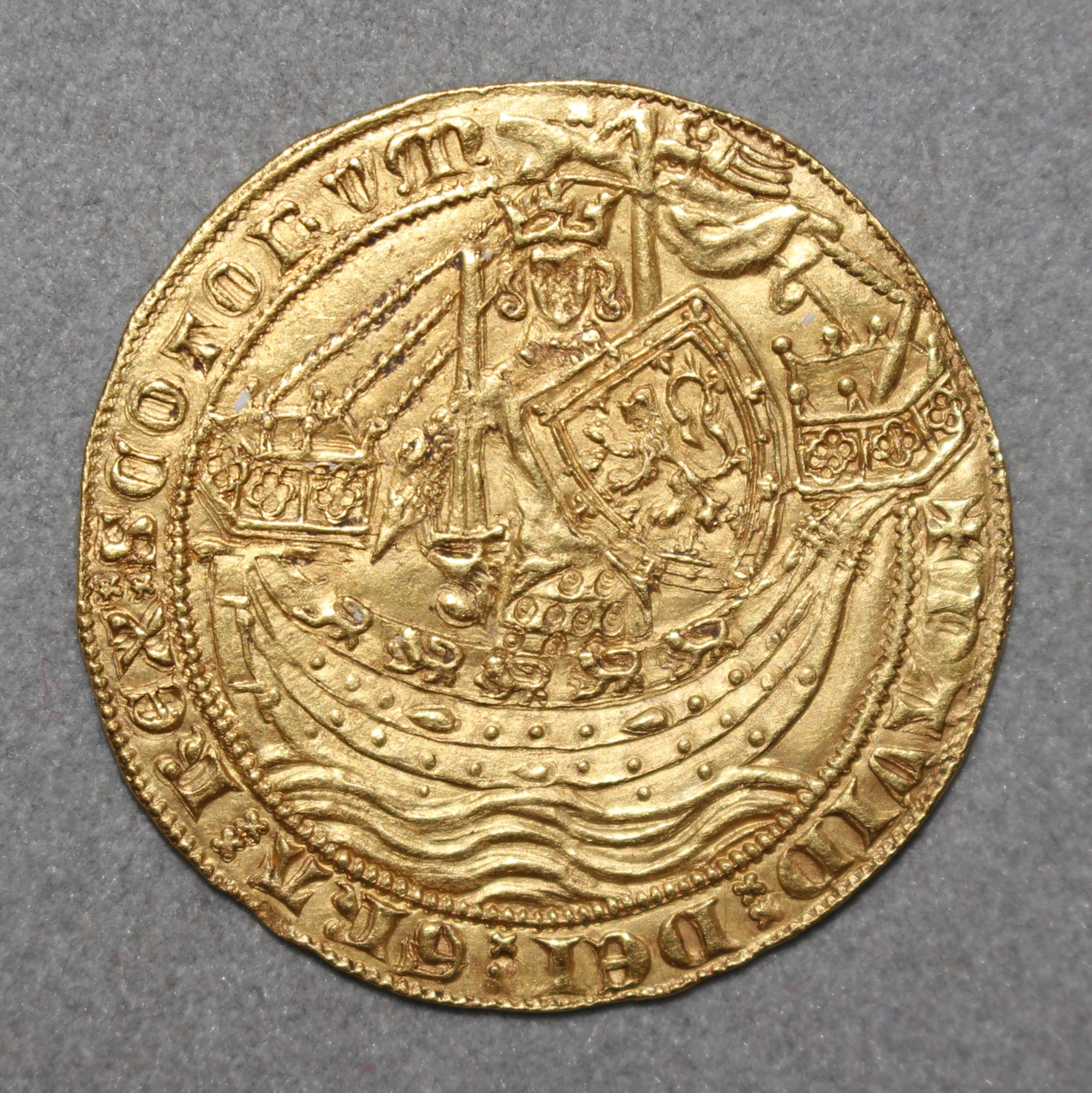Cameron Maclean talks us through some of Scotland’s earliest coins, and how our first gold coin came to be minted.
The earliest Scottish coins were minted by King David I (r.1124-1153) in 1136. Initially, only silver pennies were produced. Scotland’s coinage consisted solely of silver coins for the next two centuries. 12 pence made up a shilling and there were 20 shillings, or 240 pence, in a pound. It wasn’t until the reign of David II (r.1329-1371) that Scotland’s first gold coin was introduced.
Silver in Scotland
By the accession of David II in 1329, only silver pennies, halfpennies and farthings (quarter of a penny) were minted. These three denominations are typified by examples issued by Robert the Bruce (r.1306-1329), David II’s father. The farthing is tiny. It measures just 12.4 millimetres in diameter and weighs 0.24 grams. While small, these coins had considerable value. In 1325, a stone of cheese could be bought for between 6 and 12 pence.


David II invaded England in support of France, which was undergoing an English invasion, in 1346. This culminated in the Scots’ defeat at the Battle of Neville’s Cross on 17 October 1346. David, who sustained two arrow wounds to the head, was captured. He spent the next eleven years as a prisoner of Edward III (r.1327-1377). David’s long spell in captivity would ultimately lead to the issue of Scotland’s first gold coin.
The Gold Noble in England
In 1344, two years prior to David’s capture, Edward III introduced the gold noble. It was the first English gold coin to see widespread circulation. The noble had a value of six shillings and eight pence. This amounted to half of a mark (called a merk in Scots). The mark/merk was a common unit of account in both Scotland and England.


David II would have become familiar with these new English gold coins during his captivity, particularly as he spent much of it at the Tower of London, the fortress that housed the main English mint.
David’s release was secured in 1357 in return for the payment of a massive ransom of 100,000 merks (66,666 pounds, 13 shillings and four pence). To put this sum into perspective, it would take 200,000 gold nobles or 16,000,000 silver pennies to pay off the entire ransom.
Scotland’s First Gold Coin
Soon after his return home, David instituted a new coinage that included a Scottish noble modelled on the English one. Its design closely follows the English coin and is of the same weight (7.78 grams). Both obverses portray the king in a ship, wielding a sword and shield of arms. The only major differences are the monarchs’ respective titles and heraldry.
The Scottish coin titles the king in Latin as: DAVID : DEI : GRA : REX : SCOTORVM (‘David, by the Grace of God, King of Scots’) and the English coin reads: EDWARD · DEI · GRA · REX · ANGL · & · FRANC · D · HYB (‘Edward, by the Grace of God, King of England and France, Lord of Ireland’).
David II’s shield bears the lion rampant of Scotland, whereas Edward III’s depicts the three lions of England and the fleur-de-lis of France.
The reverse also mimics the English coin. It contains an elaborate cross with crowned lions in its quarters. The only marked difference is that an ‘E’ (backwards on the photographed example) appears at the centre of the cross on the English coin and a five-petalled flower occurs on the Scottish noble.


As the ‘E’ stands for Edward III’s name, it wouldn’t have been appropriate to replicate it on the Scottish coin. Both coins feature the same inscription: IHC · AUTEM · TRANCIENS · P · MEDIUM · ILLORUM · IBAT (But Jesus, passing through the midst of them, went his way’), a quotation from the Gospel of Luke.
A Rare Scottish Noble
The noble of David II is exceedingly rare. Only four surviving examples are known, all of which are housed in museums. The Hunterian’s specimen is from the collection of William Hunter, whose bequest forms the foundation of the museum.
Hunter’s coin was found on or about 10 June 1775 during the demolition of Fenwick Tower in the north of England. It was concealed under the floor of the tower alongside over 200 English nobles of Edward III and Richard II (r.1377-1399). Hunter purchased it for £21 on 10 March 1780.
Low numbers of surviving coins could indicate that few were minted to begin with. It’s also possible that they were produced to contribute towards paying off David’s 100,000 merk ransom.
This could account for their rarity as, once they had been delivered to the English treasury, they would have likely been melted down and made into English coins.

While the Scottish noble was first struck in c.1357, it’s not certain for how long. Minting is unlikely to have continued beyond 1367, when David II introduced a new, lighter silver coinage.
It wasn’t until the reign of Robert III (r.1390-1406) that gold coins were produced again and became a regular part of Scotland’s coinage. Every Scottish monarch from Robert III to Charles I (r.1625-1649) minted gold coins. William II (r.1689-1702) issued small numbers of gold pistoles (£12) and half pistoles (£6) in 1701. These are the last Scottish gold coins to be struck.
You can currently see a gold pistole in the coin cabinet on display in the Hunterian Art Gallery.
If you want to find out more about The Hunterian’s numismatics collection, why not explore our online catalogue?
And there are more brilliant blogs by Cameron and others stretching right across our collection for you to enjoy – covering coins, medals and much more!

